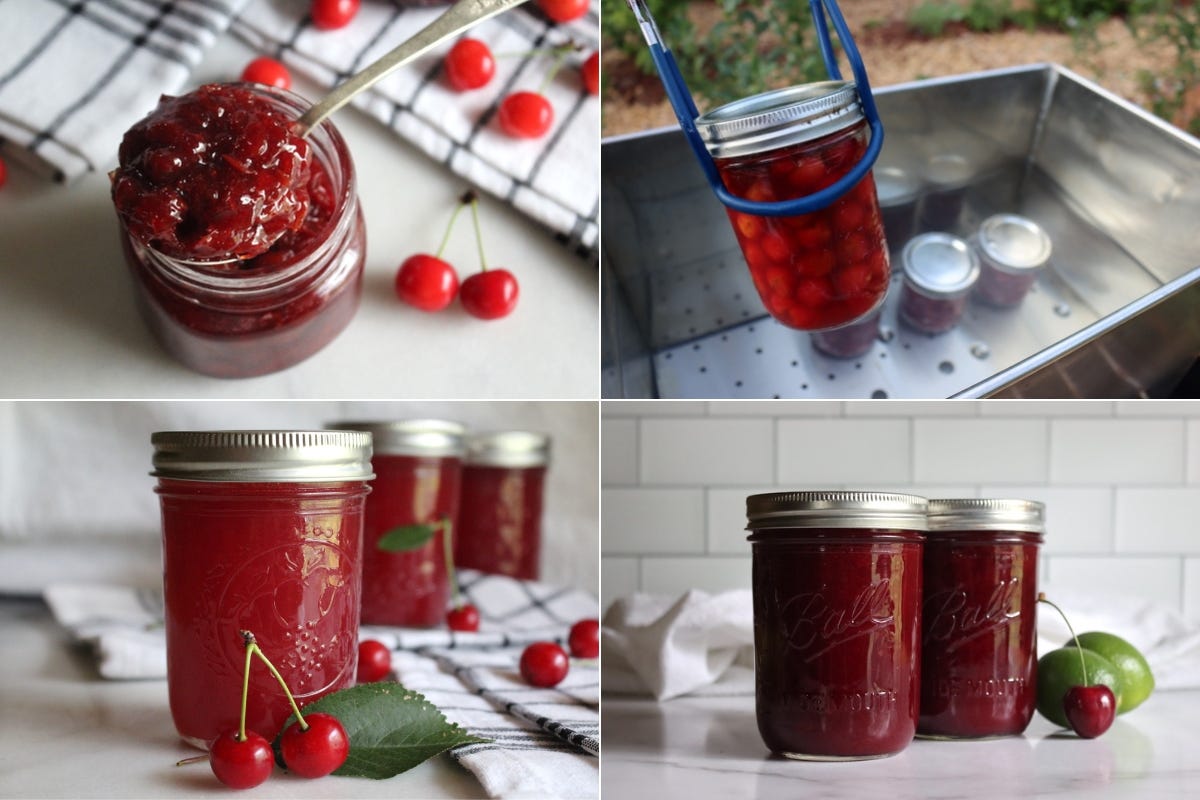In the north country, we grow a special kind of cherry called sour cherries. Some people call them pie cherries, or tart cherries, but they are in fact, sour. What they lack in sweetness, they make up for in incredible cherry flavor.
Add a bit of sugar, and you’ve got something really special.
This newsletter contains affiliate links.
If you’ve ever wondered why “cherry” candy doesn’t really taste like a grocery store Bing cherry, it’s because we’ll… Bing cherries don’t have that classic “cherry” flavor. They’re good, of course, and sweet, but with a taste more like a sweet red wine.
Northern sour cherries have an intense cherry flavor that’s perfect for pie and preserves ( or Cherry Wine), where sour is actually a benefit because it helps balance the sugar.
These beauties don’t just taste different, they actually pit differently too. They’re very soft fleshed, and they won’t stand up to transport or handling. Once off the tree, they’ve got a day at most before they start to disintegrate.
They’re tricky to pit with a regular hand pitter, as they fall apart as the pit comes out. They’d call clingstone in peaches, and working with them is a labor of love.
But…seeing as these little beauties have been around since the olden days, smart homesteaders devised a solution to have their pie cherries and eat them too.
Old-fashioned cast iron cherry pitters have a wheel that pushes the cherries through a pitting plate, stripping the cherry flesh away from the stone just as fast as you can turn the wheel.
Many of them are counter-mounted, but some have a fancy spider-leg design, like mine in the picture above.
Ideally, they’d be mounted to a counter or butcher block, but I kind of like mine portable. It just means I need two hands to run it, one holding it and the other spinning the wheel.
You can see the design variations on a site like Etsy, as these are popular in vintage markets. Some old designs work like modern ones and punch the seed out, but you’re still working one at a time.
If you get that wheel moving, you can fly through a gallon of cherries in just a few minutes, or about as fast as you can load them into the little hopper.
Here, I’m running it slowly, since I’m holding the camera with one hand, but this quick clip gives you some idea how it works:
The downside, though, is that these old-school wheel pitters don’t work on modern grocery store sweet cherries, which are bred with firm flesh for transport. Try as you might, they’ll just jam it up.
Old-school pitters need old-school fruit.
We have half a dozen pie cherry trees, and though they’re just a few years old, they’re already producing by the bucketload.
They’re precocious trees, and they’re only usually 2-3 years to first fruit, then after that they go all out.
We particularly love cherry preserves of all kinds, so once we’re done picking at home, we head on down the road to the local Pick Your Own farm.
It’s partly for the cherries, of course, but also for the wagon rides, fresh handmade donuts, and who can forget the incredible views.
Once you get into the thick of the cherry trees, the branches are so full of fruit that I’m liable to lose track of the littles as they dart around, playing tag between the limbs.
It almost always turns into a game of cherry hide and seek, but once my bags are filled, all I have to do is call out that it’s time for donuts, and my mischievous little ones appear almost instantly to pull the wagon down the hill to the farmstand.
So what does one do with all those sour cherries, you ask?
Well, they go into all my favorite Cherry Canning Recipes, of course!
My husband’s favorite is Sour Cherry Jam, made the old fashioned way with just cherries and sugar to concentrate the flavor. I like Canning Whole Cherries in syrup, and I serve them over yogurt on Christmas morning each year.
My daughter’s partial to Cherry Butter (like apple butter, but OMG, so much better!), and my son loves Cherry Jelly.
We all enjoy a glass of cherry limeaid that I can each year, and that one works just as well with sweet cherries, too.
And, of course, what’s an epic pie cherry harvest without cherry pie?
In season, I make them fresh, but canning cherry pie filling lets me save them for later on in the year. (And cherry pie is pretty magic in the winter months.)
Just about all of this cherry tastiness gets put up in my outdoor canning kitchen, in my High-Capacity Amish Canner that can hold 36-pint jars at a time.
It’s really handy for bulk harvests like this, and it’s a lifesaver in tomato season, too.
One of our big projects this year thus far has been building a more permanent outdoor canning kitchen instead of my quick and dirty setup in our blueberry patch, and later on this week, I’m going to give you all a tour of my new workspace.
I just put up a big batch of sour cherry jam in my new outdoor kitchen this week, and I can’t wait to share it with you all.
Until Next Time,
Ashley at Practical Self Reliance













Everything looks so beautiful! Love that rich cherry colour. I can't wait to see your canning kitchen!
I really enjoyed reading this this morning, so informative. Thanks for all the ideas for different ways to preserve cherries. Congratulations on your new canning kitchen, that will be one hard working kitchen I’m sure. I bet you are thrilled!